Contract Law Report: Essential Elements, Types, and Terms Evaluation
VerifiedAdded on 2020/01/28
|14
|5114
|77
Report
AI Summary
This report provides a comprehensive overview of contract law, beginning with the essential elements required for a valid contract, such as offer and acceptance, consideration, and the intention to create a legal relationship. It then delves into different types of contracts, including distance contracts, face-to-face contracts, oral contracts, and written contracts, as well as bilateral and unilateral contracts, and void and voidable contracts. The report also examines various forms of contractual terms, including express terms, implied terms, and exclusion clauses. Furthermore, the assignment evaluates a case scenario involving Mary and Film Flops, applying relevant contract law principles to analyze the elements of the contract, the applicable laws on terms, and available remedies. Finally, it contrasts liability in tort with contractual liability, exploring the nature of liability in negligence, vicarious liability, and the application of tort of negligence elements within the scenario.
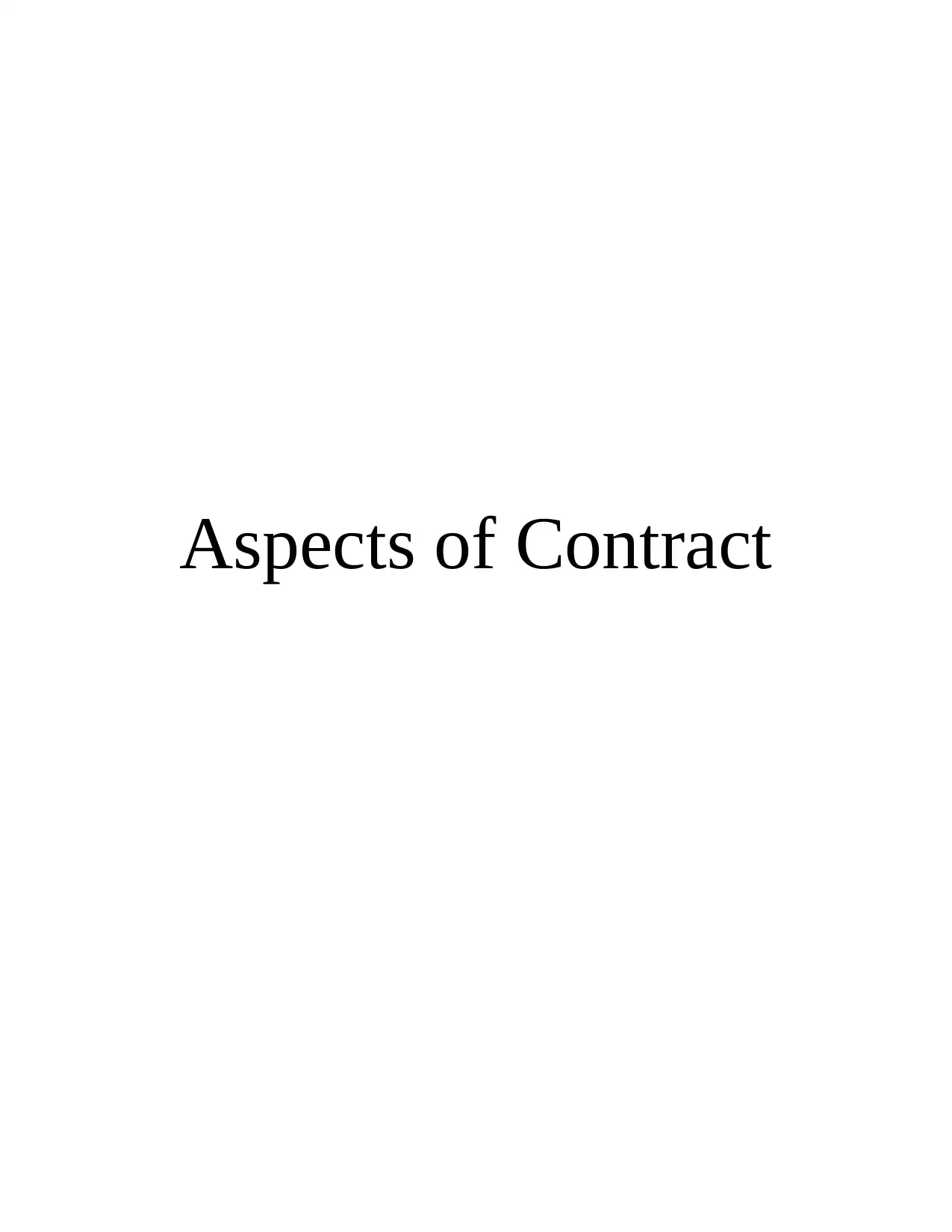
Aspects of Contract
Paraphrase This Document
Need a fresh take? Get an instant paraphrase of this document with our AI Paraphraser
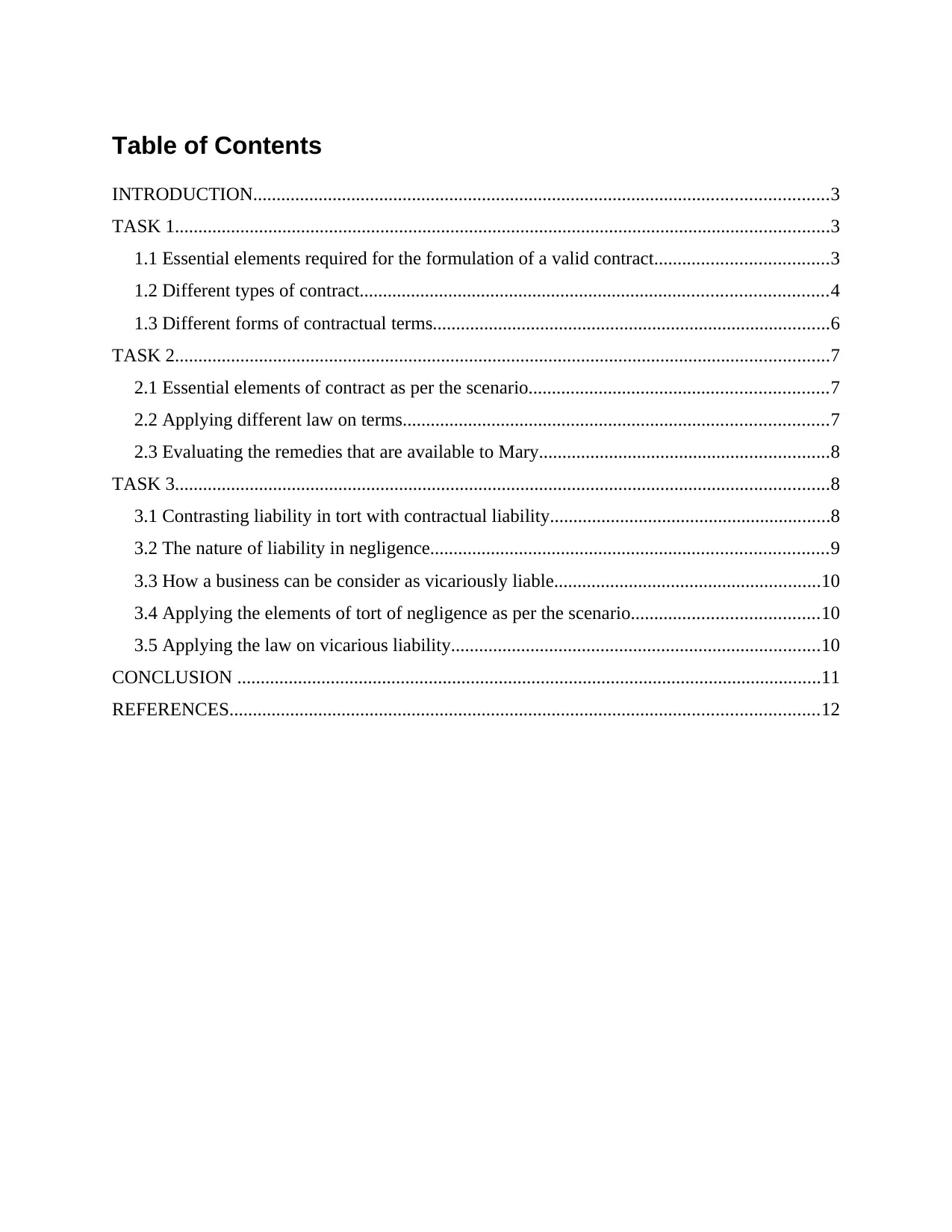
Table of Contents
INTRODUCTION...........................................................................................................................3
TASK 1............................................................................................................................................3
1.1 Essential elements required for the formulation of a valid contract.....................................3
1.2 Different types of contract....................................................................................................4
1.3 Different forms of contractual terms.....................................................................................6
TASK 2............................................................................................................................................7
2.1 Essential elements of contract as per the scenario................................................................7
2.2 Applying different law on terms...........................................................................................7
2.3 Evaluating the remedies that are available to Mary..............................................................8
TASK 3............................................................................................................................................8
3.1 Contrasting liability in tort with contractual liability............................................................8
3.2 The nature of liability in negligence.....................................................................................9
3.3 How a business can be consider as vicariously liable.........................................................10
3.4 Applying the elements of tort of negligence as per the scenario........................................10
3.5 Applying the law on vicarious liability...............................................................................10
CONCLUSION .............................................................................................................................11
REFERENCES..............................................................................................................................12
INTRODUCTION...........................................................................................................................3
TASK 1............................................................................................................................................3
1.1 Essential elements required for the formulation of a valid contract.....................................3
1.2 Different types of contract....................................................................................................4
1.3 Different forms of contractual terms.....................................................................................6
TASK 2............................................................................................................................................7
2.1 Essential elements of contract as per the scenario................................................................7
2.2 Applying different law on terms...........................................................................................7
2.3 Evaluating the remedies that are available to Mary..............................................................8
TASK 3............................................................................................................................................8
3.1 Contrasting liability in tort with contractual liability............................................................8
3.2 The nature of liability in negligence.....................................................................................9
3.3 How a business can be consider as vicariously liable.........................................................10
3.4 Applying the elements of tort of negligence as per the scenario........................................10
3.5 Applying the law on vicarious liability...............................................................................10
CONCLUSION .............................................................................................................................11
REFERENCES..............................................................................................................................12
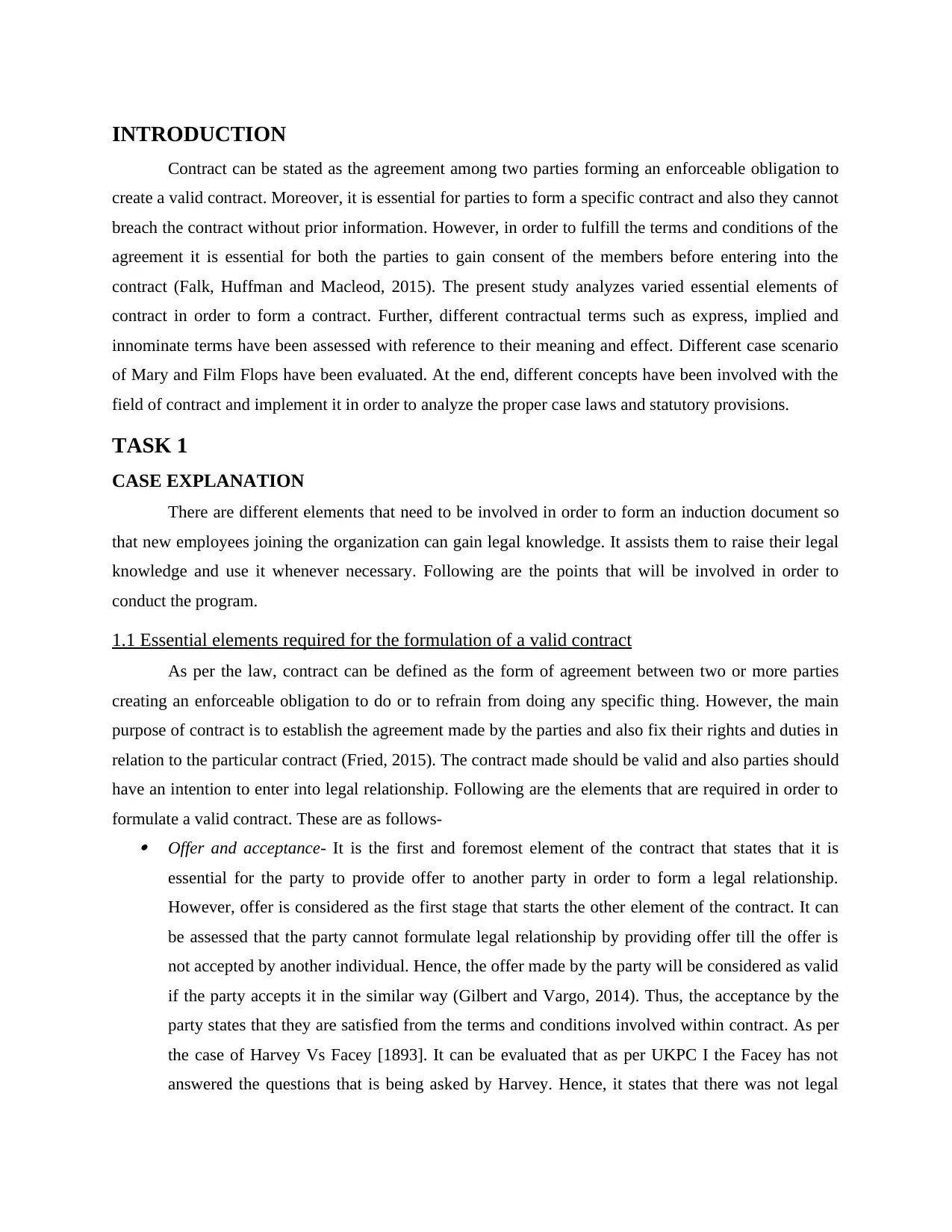
INTRODUCTION
Contract can be stated as the agreement among two parties forming an enforceable obligation to
create a valid contract. Moreover, it is essential for parties to form a specific contract and also they cannot
breach the contract without prior information. However, in order to fulfill the terms and conditions of the
agreement it is essential for both the parties to gain consent of the members before entering into the
contract (Falk, Huffman and Macleod, 2015). The present study analyzes varied essential elements of
contract in order to form a contract. Further, different contractual terms such as express, implied and
innominate terms have been assessed with reference to their meaning and effect. Different case scenario
of Mary and Film Flops have been evaluated. At the end, different concepts have been involved with the
field of contract and implement it in order to analyze the proper case laws and statutory provisions.
TASK 1
CASE EXPLANATION
There are different elements that need to be involved in order to form an induction document so
that new employees joining the organization can gain legal knowledge. It assists them to raise their legal
knowledge and use it whenever necessary. Following are the points that will be involved in order to
conduct the program.
1.1 Essential elements required for the formulation of a valid contract
As per the law, contract can be defined as the form of agreement between two or more parties
creating an enforceable obligation to do or to refrain from doing any specific thing. However, the main
purpose of contract is to establish the agreement made by the parties and also fix their rights and duties in
relation to the particular contract (Fried, 2015). The contract made should be valid and also parties should
have an intention to enter into legal relationship. Following are the elements that are required in order to
formulate a valid contract. These are as follows- Offer and acceptance- It is the first and foremost element of the contract that states that it is
essential for the party to provide offer to another party in order to form a legal relationship.
However, offer is considered as the first stage that starts the other element of the contract. It can
be assessed that the party cannot formulate legal relationship by providing offer till the offer is
not accepted by another individual. Hence, the offer made by the party will be considered as valid
if the party accepts it in the similar way (Gilbert and Vargo, 2014). Thus, the acceptance by the
party states that they are satisfied from the terms and conditions involved within contract. As per
the case of Harvey Vs Facey [1893]. It can be evaluated that as per UKPC I the Facey has not
answered the questions that is being asked by Harvey. Hence, it states that there was not legal
Contract can be stated as the agreement among two parties forming an enforceable obligation to
create a valid contract. Moreover, it is essential for parties to form a specific contract and also they cannot
breach the contract without prior information. However, in order to fulfill the terms and conditions of the
agreement it is essential for both the parties to gain consent of the members before entering into the
contract (Falk, Huffman and Macleod, 2015). The present study analyzes varied essential elements of
contract in order to form a contract. Further, different contractual terms such as express, implied and
innominate terms have been assessed with reference to their meaning and effect. Different case scenario
of Mary and Film Flops have been evaluated. At the end, different concepts have been involved with the
field of contract and implement it in order to analyze the proper case laws and statutory provisions.
TASK 1
CASE EXPLANATION
There are different elements that need to be involved in order to form an induction document so
that new employees joining the organization can gain legal knowledge. It assists them to raise their legal
knowledge and use it whenever necessary. Following are the points that will be involved in order to
conduct the program.
1.1 Essential elements required for the formulation of a valid contract
As per the law, contract can be defined as the form of agreement between two or more parties
creating an enforceable obligation to do or to refrain from doing any specific thing. However, the main
purpose of contract is to establish the agreement made by the parties and also fix their rights and duties in
relation to the particular contract (Fried, 2015). The contract made should be valid and also parties should
have an intention to enter into legal relationship. Following are the elements that are required in order to
formulate a valid contract. These are as follows- Offer and acceptance- It is the first and foremost element of the contract that states that it is
essential for the party to provide offer to another party in order to form a legal relationship.
However, offer is considered as the first stage that starts the other element of the contract. It can
be assessed that the party cannot formulate legal relationship by providing offer till the offer is
not accepted by another individual. Hence, the offer made by the party will be considered as valid
if the party accepts it in the similar way (Gilbert and Vargo, 2014). Thus, the acceptance by the
party states that they are satisfied from the terms and conditions involved within contract. As per
the case of Harvey Vs Facey [1893]. It can be evaluated that as per UKPC I the Facey has not
answered the questions that is being asked by Harvey. Hence, it states that there was not legal
⊘ This is a preview!⊘
Do you want full access?
Subscribe today to unlock all pages.

Trusted by 1+ million students worldwide
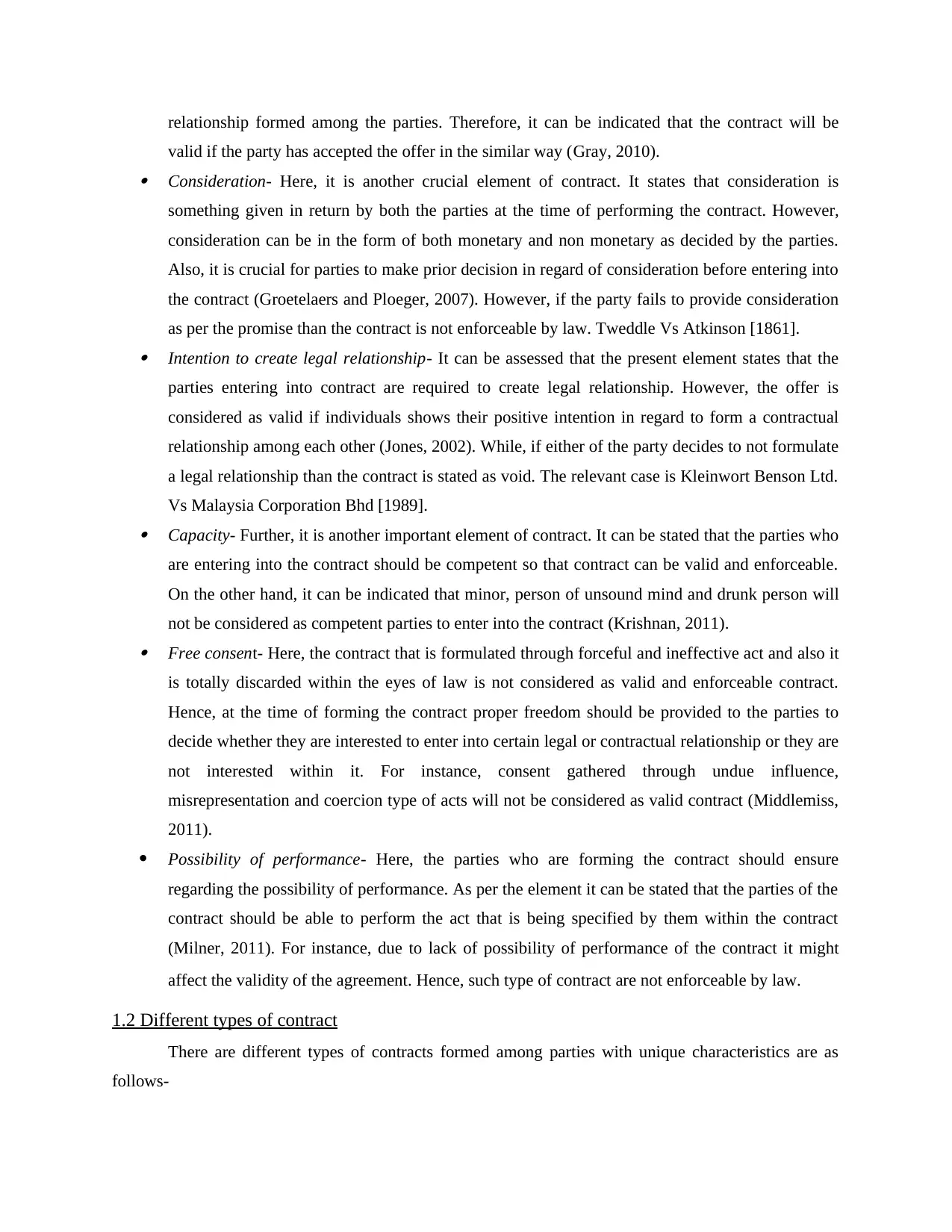
relationship formed among the parties. Therefore, it can be indicated that the contract will be
valid if the party has accepted the offer in the similar way (Gray, 2010). Consideration- Here, it is another crucial element of contract. It states that consideration is
something given in return by both the parties at the time of performing the contract. However,
consideration can be in the form of both monetary and non monetary as decided by the parties.
Also, it is crucial for parties to make prior decision in regard of consideration before entering into
the contract (Groetelaers and Ploeger, 2007). However, if the party fails to provide consideration
as per the promise than the contract is not enforceable by law. Tweddle Vs Atkinson [1861]. Intention to create legal relationship- It can be assessed that the present element states that the
parties entering into contract are required to create legal relationship. However, the offer is
considered as valid if individuals shows their positive intention in regard to form a contractual
relationship among each other (Jones, 2002). While, if either of the party decides to not formulate
a legal relationship than the contract is stated as void. The relevant case is Kleinwort Benson Ltd.
Vs Malaysia Corporation Bhd [1989]. Capacity- Further, it is another important element of contract. It can be stated that the parties who
are entering into the contract should be competent so that contract can be valid and enforceable.
On the other hand, it can be indicated that minor, person of unsound mind and drunk person will
not be considered as competent parties to enter into the contract (Krishnan, 2011). Free consent- Here, the contract that is formulated through forceful and ineffective act and also it
is totally discarded within the eyes of law is not considered as valid and enforceable contract.
Hence, at the time of forming the contract proper freedom should be provided to the parties to
decide whether they are interested to enter into certain legal or contractual relationship or they are
not interested within it. For instance, consent gathered through undue influence,
misrepresentation and coercion type of acts will not be considered as valid contract (Middlemiss,
2011).
Possibility of performance- Here, the parties who are forming the contract should ensure
regarding the possibility of performance. As per the element it can be stated that the parties of the
contract should be able to perform the act that is being specified by them within the contract
(Milner, 2011). For instance, due to lack of possibility of performance of the contract it might
affect the validity of the agreement. Hence, such type of contract are not enforceable by law.
1.2 Different types of contract
There are different types of contracts formed among parties with unique characteristics are as
follows-
valid if the party has accepted the offer in the similar way (Gray, 2010). Consideration- Here, it is another crucial element of contract. It states that consideration is
something given in return by both the parties at the time of performing the contract. However,
consideration can be in the form of both monetary and non monetary as decided by the parties.
Also, it is crucial for parties to make prior decision in regard of consideration before entering into
the contract (Groetelaers and Ploeger, 2007). However, if the party fails to provide consideration
as per the promise than the contract is not enforceable by law. Tweddle Vs Atkinson [1861]. Intention to create legal relationship- It can be assessed that the present element states that the
parties entering into contract are required to create legal relationship. However, the offer is
considered as valid if individuals shows their positive intention in regard to form a contractual
relationship among each other (Jones, 2002). While, if either of the party decides to not formulate
a legal relationship than the contract is stated as void. The relevant case is Kleinwort Benson Ltd.
Vs Malaysia Corporation Bhd [1989]. Capacity- Further, it is another important element of contract. It can be stated that the parties who
are entering into the contract should be competent so that contract can be valid and enforceable.
On the other hand, it can be indicated that minor, person of unsound mind and drunk person will
not be considered as competent parties to enter into the contract (Krishnan, 2011). Free consent- Here, the contract that is formulated through forceful and ineffective act and also it
is totally discarded within the eyes of law is not considered as valid and enforceable contract.
Hence, at the time of forming the contract proper freedom should be provided to the parties to
decide whether they are interested to enter into certain legal or contractual relationship or they are
not interested within it. For instance, consent gathered through undue influence,
misrepresentation and coercion type of acts will not be considered as valid contract (Middlemiss,
2011).
Possibility of performance- Here, the parties who are forming the contract should ensure
regarding the possibility of performance. As per the element it can be stated that the parties of the
contract should be able to perform the act that is being specified by them within the contract
(Milner, 2011). For instance, due to lack of possibility of performance of the contract it might
affect the validity of the agreement. Hence, such type of contract are not enforceable by law.
1.2 Different types of contract
There are different types of contracts formed among parties with unique characteristics are as
follows-
Paraphrase This Document
Need a fresh take? Get an instant paraphrase of this document with our AI Paraphraser
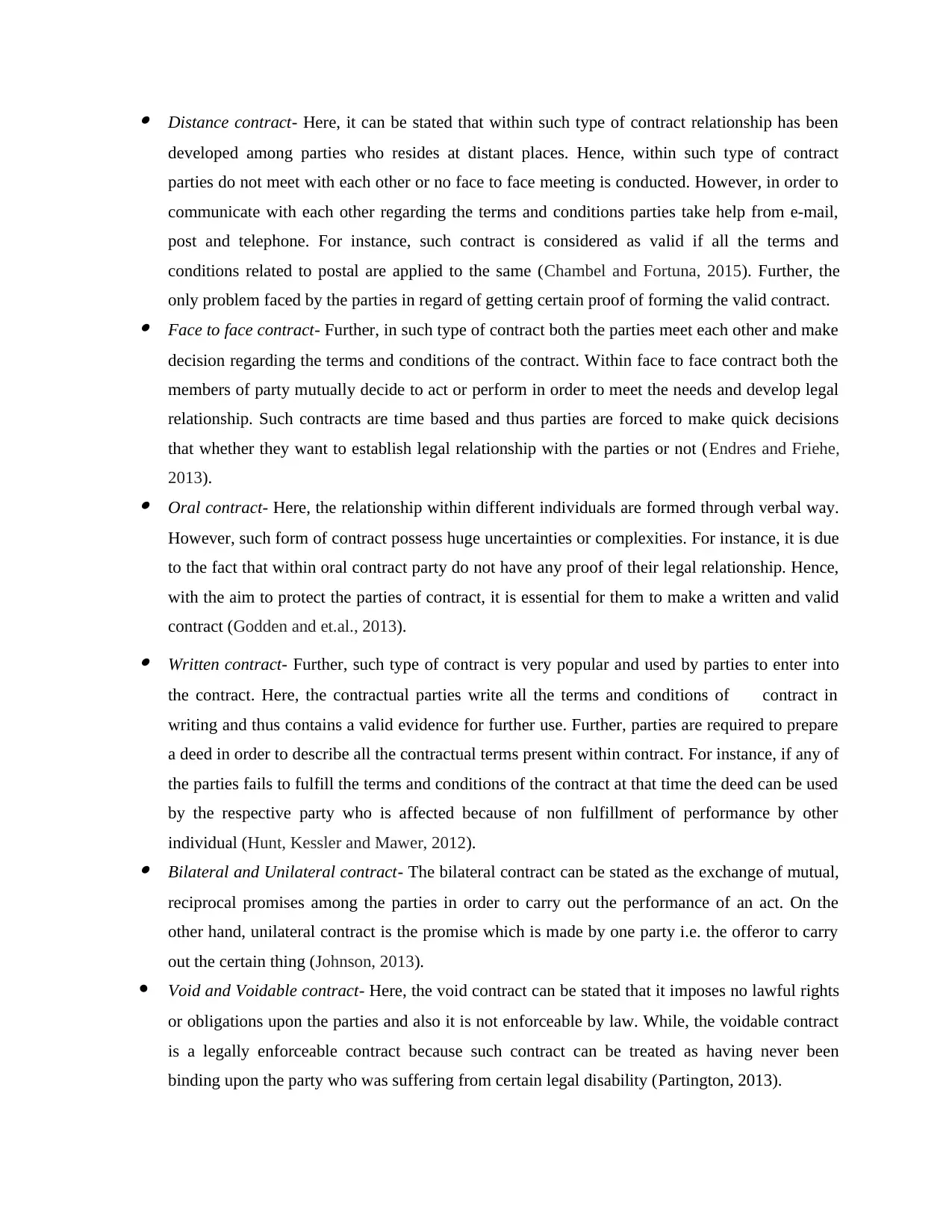
Distance contract- Here, it can be stated that within such type of contract relationship has been
developed among parties who resides at distant places. Hence, within such type of contract
parties do not meet with each other or no face to face meeting is conducted. However, in order to
communicate with each other regarding the terms and conditions parties take help from e-mail,
post and telephone. For instance, such contract is considered as valid if all the terms and
conditions related to postal are applied to the same (Chambel and Fortuna, 2015). Further, the
only problem faced by the parties in regard of getting certain proof of forming the valid contract. Face to face contract- Further, in such type of contract both the parties meet each other and make
decision regarding the terms and conditions of the contract. Within face to face contract both the
members of party mutually decide to act or perform in order to meet the needs and develop legal
relationship. Such contracts are time based and thus parties are forced to make quick decisions
that whether they want to establish legal relationship with the parties or not (Endres and Friehe,
2013). Oral contract- Here, the relationship within different individuals are formed through verbal way.
However, such form of contract possess huge uncertainties or complexities. For instance, it is due
to the fact that within oral contract party do not have any proof of their legal relationship. Hence,
with the aim to protect the parties of contract, it is essential for them to make a written and valid
contract (Godden and et.al., 2013). Written contract- Further, such type of contract is very popular and used by parties to enter into
the contract. Here, the contractual parties write all the terms and conditions of contract in
writing and thus contains a valid evidence for further use. Further, parties are required to prepare
a deed in order to describe all the contractual terms present within contract. For instance, if any of
the parties fails to fulfill the terms and conditions of the contract at that time the deed can be used
by the respective party who is affected because of non fulfillment of performance by other
individual (Hunt, Kessler and Mawer, 2012). Bilateral and Unilateral contract- The bilateral contract can be stated as the exchange of mutual,
reciprocal promises among the parties in order to carry out the performance of an act. On the
other hand, unilateral contract is the promise which is made by one party i.e. the offeror to carry
out the certain thing (Johnson, 2013).
Void and Voidable contract- Here, the void contract can be stated that it imposes no lawful rights
or obligations upon the parties and also it is not enforceable by law. While, the voidable contract
is a legally enforceable contract because such contract can be treated as having never been
binding upon the party who was suffering from certain legal disability (Partington, 2013).
developed among parties who resides at distant places. Hence, within such type of contract
parties do not meet with each other or no face to face meeting is conducted. However, in order to
communicate with each other regarding the terms and conditions parties take help from e-mail,
post and telephone. For instance, such contract is considered as valid if all the terms and
conditions related to postal are applied to the same (Chambel and Fortuna, 2015). Further, the
only problem faced by the parties in regard of getting certain proof of forming the valid contract. Face to face contract- Further, in such type of contract both the parties meet each other and make
decision regarding the terms and conditions of the contract. Within face to face contract both the
members of party mutually decide to act or perform in order to meet the needs and develop legal
relationship. Such contracts are time based and thus parties are forced to make quick decisions
that whether they want to establish legal relationship with the parties or not (Endres and Friehe,
2013). Oral contract- Here, the relationship within different individuals are formed through verbal way.
However, such form of contract possess huge uncertainties or complexities. For instance, it is due
to the fact that within oral contract party do not have any proof of their legal relationship. Hence,
with the aim to protect the parties of contract, it is essential for them to make a written and valid
contract (Godden and et.al., 2013). Written contract- Further, such type of contract is very popular and used by parties to enter into
the contract. Here, the contractual parties write all the terms and conditions of contract in
writing and thus contains a valid evidence for further use. Further, parties are required to prepare
a deed in order to describe all the contractual terms present within contract. For instance, if any of
the parties fails to fulfill the terms and conditions of the contract at that time the deed can be used
by the respective party who is affected because of non fulfillment of performance by other
individual (Hunt, Kessler and Mawer, 2012). Bilateral and Unilateral contract- The bilateral contract can be stated as the exchange of mutual,
reciprocal promises among the parties in order to carry out the performance of an act. On the
other hand, unilateral contract is the promise which is made by one party i.e. the offeror to carry
out the certain thing (Johnson, 2013).
Void and Voidable contract- Here, the void contract can be stated that it imposes no lawful rights
or obligations upon the parties and also it is not enforceable by law. While, the voidable contract
is a legally enforceable contract because such contract can be treated as having never been
binding upon the party who was suffering from certain legal disability (Partington, 2013).
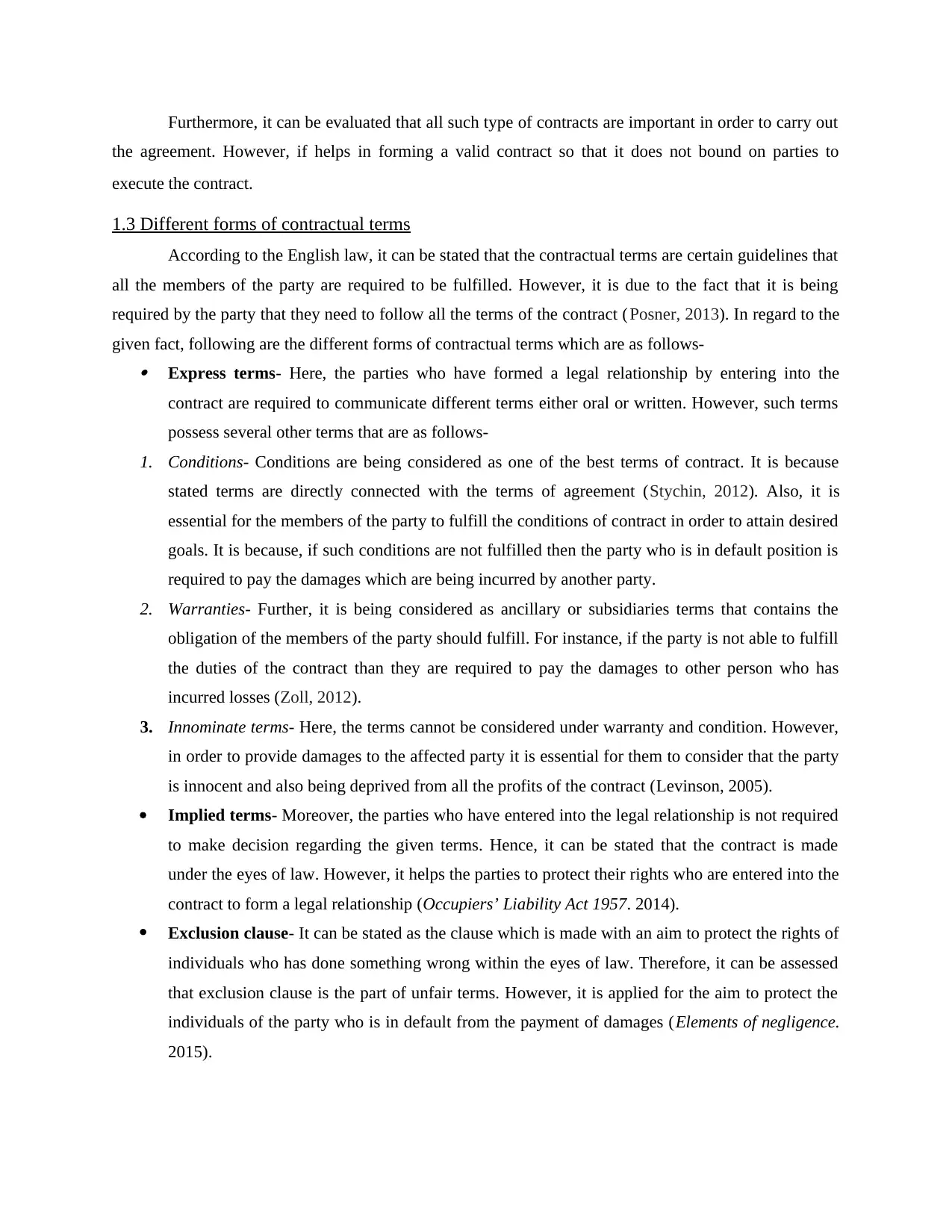
Furthermore, it can be evaluated that all such type of contracts are important in order to carry out
the agreement. However, if helps in forming a valid contract so that it does not bound on parties to
execute the contract.
1.3 Different forms of contractual terms
According to the English law, it can be stated that the contractual terms are certain guidelines that
all the members of the party are required to be fulfilled. However, it is due to the fact that it is being
required by the party that they need to follow all the terms of the contract ( Posner, 2013). In regard to the
given fact, following are the different forms of contractual terms which are as follows- Express terms- Here, the parties who have formed a legal relationship by entering into the
contract are required to communicate different terms either oral or written. However, such terms
possess several other terms that are as follows-
1. Conditions- Conditions are being considered as one of the best terms of contract. It is because
stated terms are directly connected with the terms of agreement (Stychin, 2012). Also, it is
essential for the members of the party to fulfill the conditions of contract in order to attain desired
goals. It is because, if such conditions are not fulfilled then the party who is in default position is
required to pay the damages which are being incurred by another party.
2. Warranties- Further, it is being considered as ancillary or subsidiaries terms that contains the
obligation of the members of the party should fulfill. For instance, if the party is not able to fulfill
the duties of the contract than they are required to pay the damages to other person who has
incurred losses (Zoll, 2012).
3. Innominate terms- Here, the terms cannot be considered under warranty and condition. However,
in order to provide damages to the affected party it is essential for them to consider that the party
is innocent and also being deprived from all the profits of the contract (Levinson, 2005).
Implied terms- Moreover, the parties who have entered into the legal relationship is not required
to make decision regarding the given terms. Hence, it can be stated that the contract is made
under the eyes of law. However, it helps the parties to protect their rights who are entered into the
contract to form a legal relationship (Occupiers’ Liability Act 1957. 2014).
Exclusion clause- It can be stated as the clause which is made with an aim to protect the rights of
individuals who has done something wrong within the eyes of law. Therefore, it can be assessed
that exclusion clause is the part of unfair terms. However, it is applied for the aim to protect the
individuals of the party who is in default from the payment of damages (Elements of negligence.
2015).
the agreement. However, if helps in forming a valid contract so that it does not bound on parties to
execute the contract.
1.3 Different forms of contractual terms
According to the English law, it can be stated that the contractual terms are certain guidelines that
all the members of the party are required to be fulfilled. However, it is due to the fact that it is being
required by the party that they need to follow all the terms of the contract ( Posner, 2013). In regard to the
given fact, following are the different forms of contractual terms which are as follows- Express terms- Here, the parties who have formed a legal relationship by entering into the
contract are required to communicate different terms either oral or written. However, such terms
possess several other terms that are as follows-
1. Conditions- Conditions are being considered as one of the best terms of contract. It is because
stated terms are directly connected with the terms of agreement (Stychin, 2012). Also, it is
essential for the members of the party to fulfill the conditions of contract in order to attain desired
goals. It is because, if such conditions are not fulfilled then the party who is in default position is
required to pay the damages which are being incurred by another party.
2. Warranties- Further, it is being considered as ancillary or subsidiaries terms that contains the
obligation of the members of the party should fulfill. For instance, if the party is not able to fulfill
the duties of the contract than they are required to pay the damages to other person who has
incurred losses (Zoll, 2012).
3. Innominate terms- Here, the terms cannot be considered under warranty and condition. However,
in order to provide damages to the affected party it is essential for them to consider that the party
is innocent and also being deprived from all the profits of the contract (Levinson, 2005).
Implied terms- Moreover, the parties who have entered into the legal relationship is not required
to make decision regarding the given terms. Hence, it can be stated that the contract is made
under the eyes of law. However, it helps the parties to protect their rights who are entered into the
contract to form a legal relationship (Occupiers’ Liability Act 1957. 2014).
Exclusion clause- It can be stated as the clause which is made with an aim to protect the rights of
individuals who has done something wrong within the eyes of law. Therefore, it can be assessed
that exclusion clause is the part of unfair terms. However, it is applied for the aim to protect the
individuals of the party who is in default from the payment of damages (Elements of negligence.
2015).
⊘ This is a preview!⊘
Do you want full access?
Subscribe today to unlock all pages.

Trusted by 1+ million students worldwide
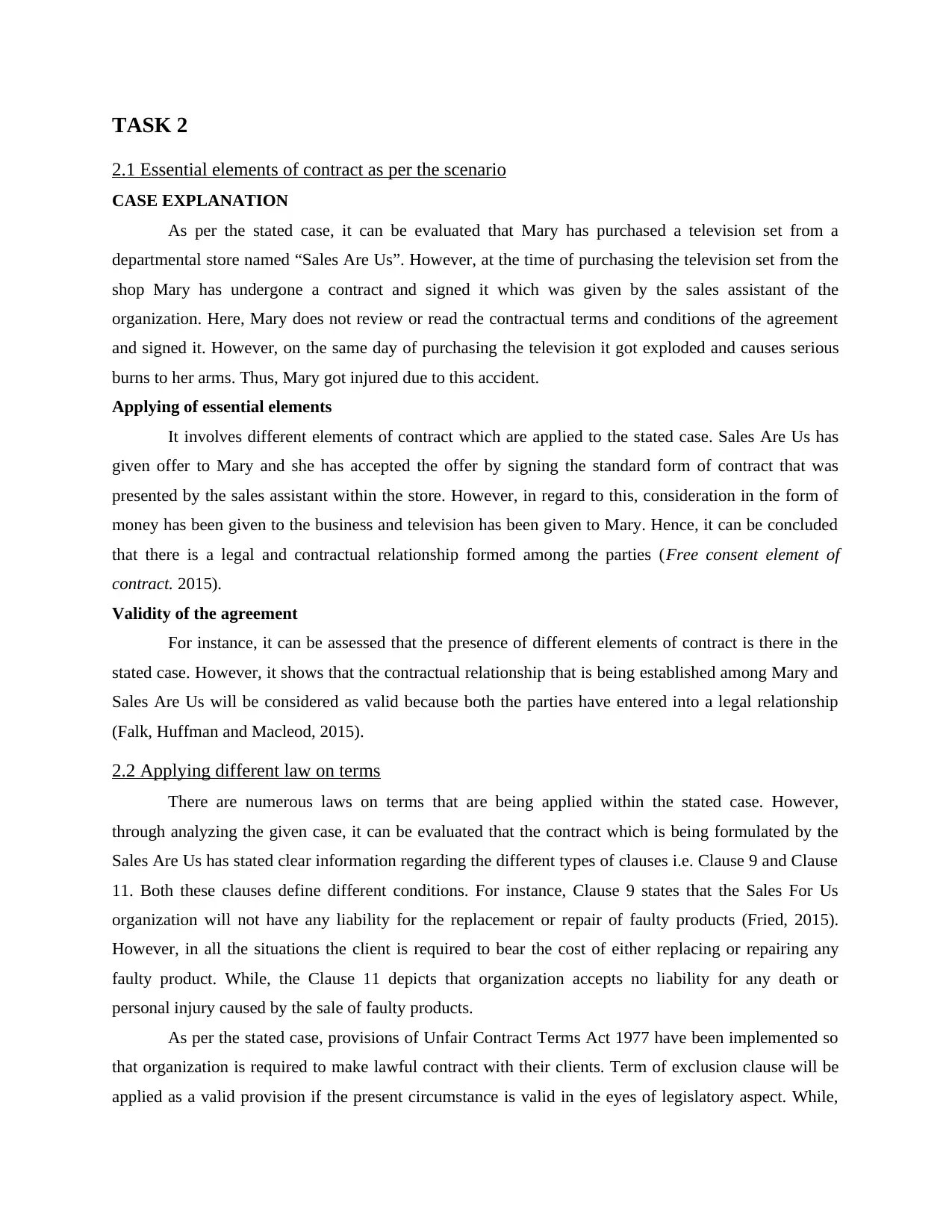
TASK 2
2.1 Essential elements of contract as per the scenario
CASE EXPLANATION
As per the stated case, it can be evaluated that Mary has purchased a television set from a
departmental store named “Sales Are Us”. However, at the time of purchasing the television set from the
shop Mary has undergone a contract and signed it which was given by the sales assistant of the
organization. Here, Mary does not review or read the contractual terms and conditions of the agreement
and signed it. However, on the same day of purchasing the television it got exploded and causes serious
burns to her arms. Thus, Mary got injured due to this accident.
Applying of essential elements
It involves different elements of contract which are applied to the stated case. Sales Are Us has
given offer to Mary and she has accepted the offer by signing the standard form of contract that was
presented by the sales assistant within the store. However, in regard to this, consideration in the form of
money has been given to the business and television has been given to Mary. Hence, it can be concluded
that there is a legal and contractual relationship formed among the parties (Free consent element of
contract. 2015).
Validity of the agreement
For instance, it can be assessed that the presence of different elements of contract is there in the
stated case. However, it shows that the contractual relationship that is being established among Mary and
Sales Are Us will be considered as valid because both the parties have entered into a legal relationship
(Falk, Huffman and Macleod, 2015).
2.2 Applying different law on terms
There are numerous laws on terms that are being applied within the stated case. However,
through analyzing the given case, it can be evaluated that the contract which is being formulated by the
Sales Are Us has stated clear information regarding the different types of clauses i.e. Clause 9 and Clause
11. Both these clauses define different conditions. For instance, Clause 9 states that the Sales For Us
organization will not have any liability for the replacement or repair of faulty products (Fried, 2015).
However, in all the situations the client is required to bear the cost of either replacing or repairing any
faulty product. While, the Clause 11 depicts that organization accepts no liability for any death or
personal injury caused by the sale of faulty products.
As per the stated case, provisions of Unfair Contract Terms Act 1977 have been implemented so
that organization is required to make lawful contract with their clients. Term of exclusion clause will be
applied as a valid provision if the present circumstance is valid in the eyes of legislatory aspect. While,
2.1 Essential elements of contract as per the scenario
CASE EXPLANATION
As per the stated case, it can be evaluated that Mary has purchased a television set from a
departmental store named “Sales Are Us”. However, at the time of purchasing the television set from the
shop Mary has undergone a contract and signed it which was given by the sales assistant of the
organization. Here, Mary does not review or read the contractual terms and conditions of the agreement
and signed it. However, on the same day of purchasing the television it got exploded and causes serious
burns to her arms. Thus, Mary got injured due to this accident.
Applying of essential elements
It involves different elements of contract which are applied to the stated case. Sales Are Us has
given offer to Mary and she has accepted the offer by signing the standard form of contract that was
presented by the sales assistant within the store. However, in regard to this, consideration in the form of
money has been given to the business and television has been given to Mary. Hence, it can be concluded
that there is a legal and contractual relationship formed among the parties (Free consent element of
contract. 2015).
Validity of the agreement
For instance, it can be assessed that the presence of different elements of contract is there in the
stated case. However, it shows that the contractual relationship that is being established among Mary and
Sales Are Us will be considered as valid because both the parties have entered into a legal relationship
(Falk, Huffman and Macleod, 2015).
2.2 Applying different law on terms
There are numerous laws on terms that are being applied within the stated case. However,
through analyzing the given case, it can be evaluated that the contract which is being formulated by the
Sales Are Us has stated clear information regarding the different types of clauses i.e. Clause 9 and Clause
11. Both these clauses define different conditions. For instance, Clause 9 states that the Sales For Us
organization will not have any liability for the replacement or repair of faulty products (Fried, 2015).
However, in all the situations the client is required to bear the cost of either replacing or repairing any
faulty product. While, the Clause 11 depicts that organization accepts no liability for any death or
personal injury caused by the sale of faulty products.
As per the stated case, provisions of Unfair Contract Terms Act 1977 have been implemented so
that organization is required to make lawful contract with their clients. Term of exclusion clause will be
applied as a valid provision if the present circumstance is valid in the eyes of legislatory aspect. While,
Paraphrase This Document
Need a fresh take? Get an instant paraphrase of this document with our AI Paraphraser
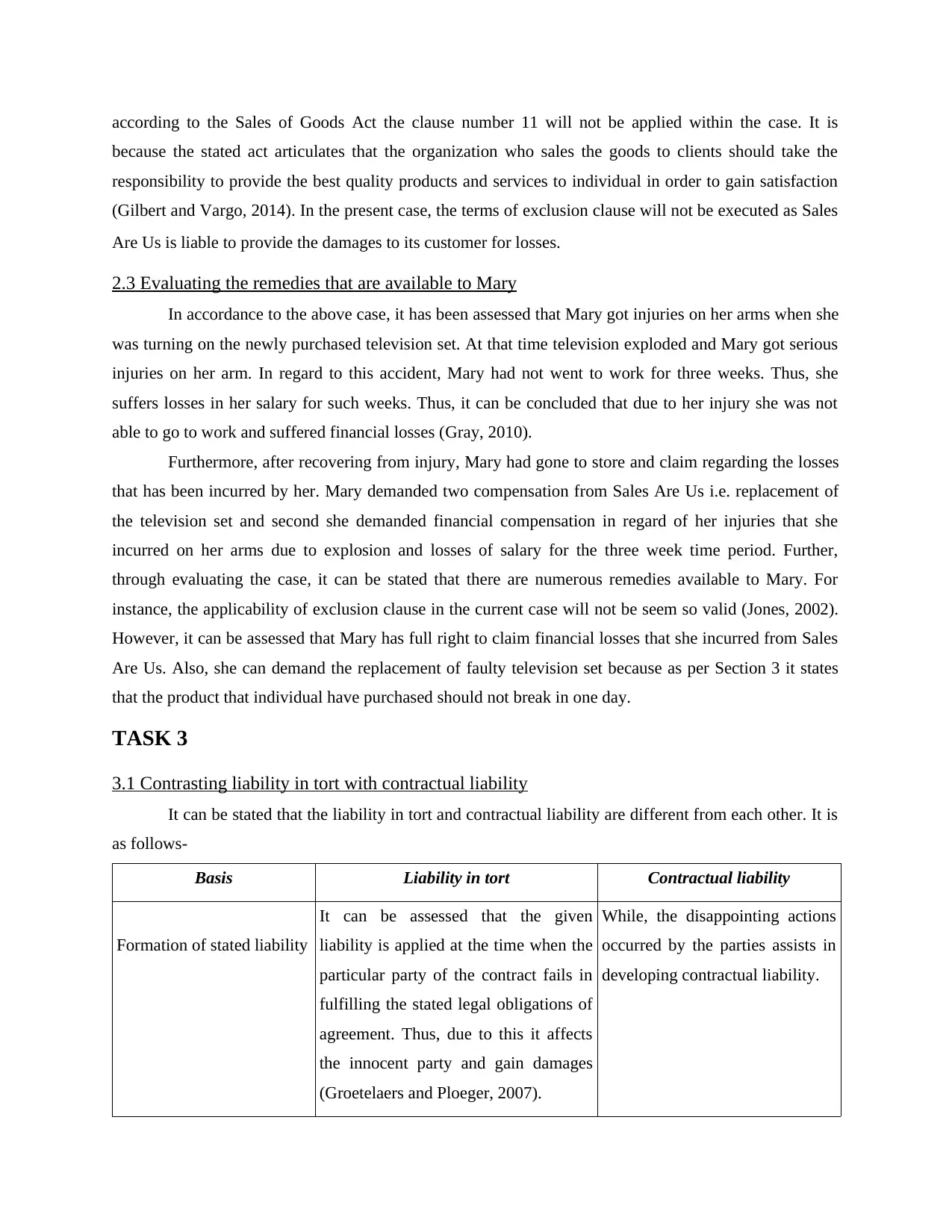
according to the Sales of Goods Act the clause number 11 will not be applied within the case. It is
because the stated act articulates that the organization who sales the goods to clients should take the
responsibility to provide the best quality products and services to individual in order to gain satisfaction
(Gilbert and Vargo, 2014). In the present case, the terms of exclusion clause will not be executed as Sales
Are Us is liable to provide the damages to its customer for losses.
2.3 Evaluating the remedies that are available to Mary
In accordance to the above case, it has been assessed that Mary got injuries on her arms when she
was turning on the newly purchased television set. At that time television exploded and Mary got serious
injuries on her arm. In regard to this accident, Mary had not went to work for three weeks. Thus, she
suffers losses in her salary for such weeks. Thus, it can be concluded that due to her injury she was not
able to go to work and suffered financial losses (Gray, 2010).
Furthermore, after recovering from injury, Mary had gone to store and claim regarding the losses
that has been incurred by her. Mary demanded two compensation from Sales Are Us i.e. replacement of
the television set and second she demanded financial compensation in regard of her injuries that she
incurred on her arms due to explosion and losses of salary for the three week time period. Further,
through evaluating the case, it can be stated that there are numerous remedies available to Mary. For
instance, the applicability of exclusion clause in the current case will not be seem so valid (Jones, 2002).
However, it can be assessed that Mary has full right to claim financial losses that she incurred from Sales
Are Us. Also, she can demand the replacement of faulty television set because as per Section 3 it states
that the product that individual have purchased should not break in one day.
TASK 3
3.1 Contrasting liability in tort with contractual liability
It can be stated that the liability in tort and contractual liability are different from each other. It is
as follows-
Basis Liability in tort Contractual liability
Formation of stated liability
It can be assessed that the given
liability is applied at the time when the
particular party of the contract fails in
fulfilling the stated legal obligations of
agreement. Thus, due to this it affects
the innocent party and gain damages
(Groetelaers and Ploeger, 2007).
While, the disappointing actions
occurred by the parties assists in
developing contractual liability.
because the stated act articulates that the organization who sales the goods to clients should take the
responsibility to provide the best quality products and services to individual in order to gain satisfaction
(Gilbert and Vargo, 2014). In the present case, the terms of exclusion clause will not be executed as Sales
Are Us is liable to provide the damages to its customer for losses.
2.3 Evaluating the remedies that are available to Mary
In accordance to the above case, it has been assessed that Mary got injuries on her arms when she
was turning on the newly purchased television set. At that time television exploded and Mary got serious
injuries on her arm. In regard to this accident, Mary had not went to work for three weeks. Thus, she
suffers losses in her salary for such weeks. Thus, it can be concluded that due to her injury she was not
able to go to work and suffered financial losses (Gray, 2010).
Furthermore, after recovering from injury, Mary had gone to store and claim regarding the losses
that has been incurred by her. Mary demanded two compensation from Sales Are Us i.e. replacement of
the television set and second she demanded financial compensation in regard of her injuries that she
incurred on her arms due to explosion and losses of salary for the three week time period. Further,
through evaluating the case, it can be stated that there are numerous remedies available to Mary. For
instance, the applicability of exclusion clause in the current case will not be seem so valid (Jones, 2002).
However, it can be assessed that Mary has full right to claim financial losses that she incurred from Sales
Are Us. Also, she can demand the replacement of faulty television set because as per Section 3 it states
that the product that individual have purchased should not break in one day.
TASK 3
3.1 Contrasting liability in tort with contractual liability
It can be stated that the liability in tort and contractual liability are different from each other. It is
as follows-
Basis Liability in tort Contractual liability
Formation of stated liability
It can be assessed that the given
liability is applied at the time when the
particular party of the contract fails in
fulfilling the stated legal obligations of
agreement. Thus, due to this it affects
the innocent party and gain damages
(Groetelaers and Ploeger, 2007).
While, the disappointing actions
occurred by the parties assists in
developing contractual liability.
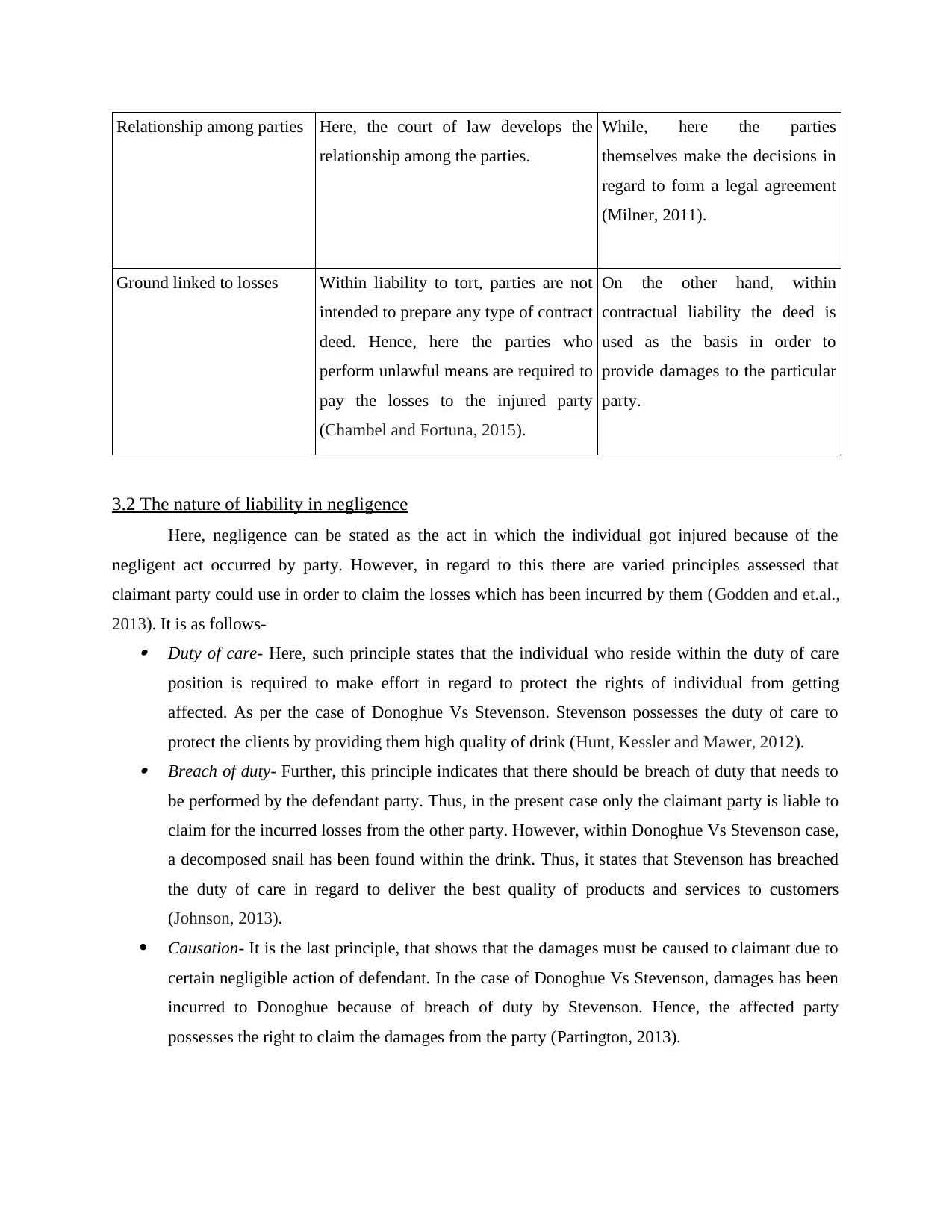
Relationship among parties Here, the court of law develops the
relationship among the parties.
While, here the parties
themselves make the decisions in
regard to form a legal agreement
(Milner, 2011).
Ground linked to losses Within liability to tort, parties are not
intended to prepare any type of contract
deed. Hence, here the parties who
perform unlawful means are required to
pay the losses to the injured party
(Chambel and Fortuna, 2015).
On the other hand, within
contractual liability the deed is
used as the basis in order to
provide damages to the particular
party.
3.2 The nature of liability in negligence
Here, negligence can be stated as the act in which the individual got injured because of the
negligent act occurred by party. However, in regard to this there are varied principles assessed that
claimant party could use in order to claim the losses which has been incurred by them (Godden and et.al.,
2013). It is as follows- Duty of care- Here, such principle states that the individual who reside within the duty of care
position is required to make effort in regard to protect the rights of individual from getting
affected. As per the case of Donoghue Vs Stevenson. Stevenson possesses the duty of care to
protect the clients by providing them high quality of drink (Hunt, Kessler and Mawer, 2012). Breach of duty- Further, this principle indicates that there should be breach of duty that needs to
be performed by the defendant party. Thus, in the present case only the claimant party is liable to
claim for the incurred losses from the other party. However, within Donoghue Vs Stevenson case,
a decomposed snail has been found within the drink. Thus, it states that Stevenson has breached
the duty of care in regard to deliver the best quality of products and services to customers
(Johnson, 2013).
Causation- It is the last principle, that shows that the damages must be caused to claimant due to
certain negligible action of defendant. In the case of Donoghue Vs Stevenson, damages has been
incurred to Donoghue because of breach of duty by Stevenson. Hence, the affected party
possesses the right to claim the damages from the party (Partington, 2013).
relationship among the parties.
While, here the parties
themselves make the decisions in
regard to form a legal agreement
(Milner, 2011).
Ground linked to losses Within liability to tort, parties are not
intended to prepare any type of contract
deed. Hence, here the parties who
perform unlawful means are required to
pay the losses to the injured party
(Chambel and Fortuna, 2015).
On the other hand, within
contractual liability the deed is
used as the basis in order to
provide damages to the particular
party.
3.2 The nature of liability in negligence
Here, negligence can be stated as the act in which the individual got injured because of the
negligent act occurred by party. However, in regard to this there are varied principles assessed that
claimant party could use in order to claim the losses which has been incurred by them (Godden and et.al.,
2013). It is as follows- Duty of care- Here, such principle states that the individual who reside within the duty of care
position is required to make effort in regard to protect the rights of individual from getting
affected. As per the case of Donoghue Vs Stevenson. Stevenson possesses the duty of care to
protect the clients by providing them high quality of drink (Hunt, Kessler and Mawer, 2012). Breach of duty- Further, this principle indicates that there should be breach of duty that needs to
be performed by the defendant party. Thus, in the present case only the claimant party is liable to
claim for the incurred losses from the other party. However, within Donoghue Vs Stevenson case,
a decomposed snail has been found within the drink. Thus, it states that Stevenson has breached
the duty of care in regard to deliver the best quality of products and services to customers
(Johnson, 2013).
Causation- It is the last principle, that shows that the damages must be caused to claimant due to
certain negligible action of defendant. In the case of Donoghue Vs Stevenson, damages has been
incurred to Donoghue because of breach of duty by Stevenson. Hence, the affected party
possesses the right to claim the damages from the party (Partington, 2013).
⊘ This is a preview!⊘
Do you want full access?
Subscribe today to unlock all pages.

Trusted by 1+ million students worldwide
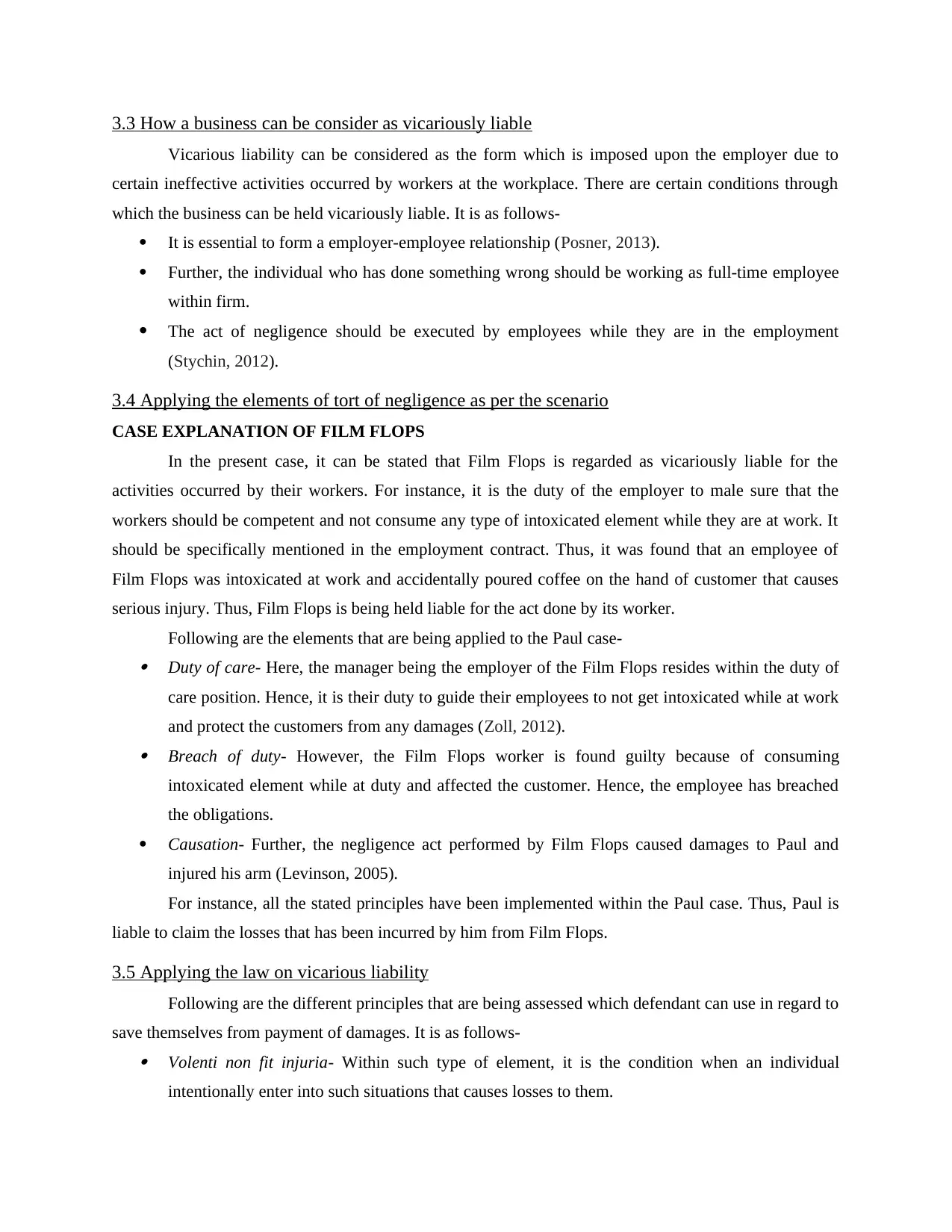
3.3 How a business can be consider as vicariously liable
Vicarious liability can be considered as the form which is imposed upon the employer due to
certain ineffective activities occurred by workers at the workplace. There are certain conditions through
which the business can be held vicariously liable. It is as follows-
It is essential to form a employer-employee relationship (Posner, 2013).
Further, the individual who has done something wrong should be working as full-time employee
within firm.
The act of negligence should be executed by employees while they are in the employment
(Stychin, 2012).
3.4 Applying the elements of tort of negligence as per the scenario
CASE EXPLANATION OF FILM FLOPS
In the present case, it can be stated that Film Flops is regarded as vicariously liable for the
activities occurred by their workers. For instance, it is the duty of the employer to male sure that the
workers should be competent and not consume any type of intoxicated element while they are at work. It
should be specifically mentioned in the employment contract. Thus, it was found that an employee of
Film Flops was intoxicated at work and accidentally poured coffee on the hand of customer that causes
serious injury. Thus, Film Flops is being held liable for the act done by its worker.
Following are the elements that are being applied to the Paul case- Duty of care- Here, the manager being the employer of the Film Flops resides within the duty of
care position. Hence, it is their duty to guide their employees to not get intoxicated while at work
and protect the customers from any damages (Zoll, 2012). Breach of duty- However, the Film Flops worker is found guilty because of consuming
intoxicated element while at duty and affected the customer. Hence, the employee has breached
the obligations.
Causation- Further, the negligence act performed by Film Flops caused damages to Paul and
injured his arm (Levinson, 2005).
For instance, all the stated principles have been implemented within the Paul case. Thus, Paul is
liable to claim the losses that has been incurred by him from Film Flops.
3.5 Applying the law on vicarious liability
Following are the different principles that are being assessed which defendant can use in regard to
save themselves from payment of damages. It is as follows- Volenti non fit injuria- Within such type of element, it is the condition when an individual
intentionally enter into such situations that causes losses to them.
Vicarious liability can be considered as the form which is imposed upon the employer due to
certain ineffective activities occurred by workers at the workplace. There are certain conditions through
which the business can be held vicariously liable. It is as follows-
It is essential to form a employer-employee relationship (Posner, 2013).
Further, the individual who has done something wrong should be working as full-time employee
within firm.
The act of negligence should be executed by employees while they are in the employment
(Stychin, 2012).
3.4 Applying the elements of tort of negligence as per the scenario
CASE EXPLANATION OF FILM FLOPS
In the present case, it can be stated that Film Flops is regarded as vicariously liable for the
activities occurred by their workers. For instance, it is the duty of the employer to male sure that the
workers should be competent and not consume any type of intoxicated element while they are at work. It
should be specifically mentioned in the employment contract. Thus, it was found that an employee of
Film Flops was intoxicated at work and accidentally poured coffee on the hand of customer that causes
serious injury. Thus, Film Flops is being held liable for the act done by its worker.
Following are the elements that are being applied to the Paul case- Duty of care- Here, the manager being the employer of the Film Flops resides within the duty of
care position. Hence, it is their duty to guide their employees to not get intoxicated while at work
and protect the customers from any damages (Zoll, 2012). Breach of duty- However, the Film Flops worker is found guilty because of consuming
intoxicated element while at duty and affected the customer. Hence, the employee has breached
the obligations.
Causation- Further, the negligence act performed by Film Flops caused damages to Paul and
injured his arm (Levinson, 2005).
For instance, all the stated principles have been implemented within the Paul case. Thus, Paul is
liable to claim the losses that has been incurred by him from Film Flops.
3.5 Applying the law on vicarious liability
Following are the different principles that are being assessed which defendant can use in regard to
save themselves from payment of damages. It is as follows- Volenti non fit injuria- Within such type of element, it is the condition when an individual
intentionally enter into such situations that causes losses to them.
Paraphrase This Document
Need a fresh take? Get an instant paraphrase of this document with our AI Paraphraser
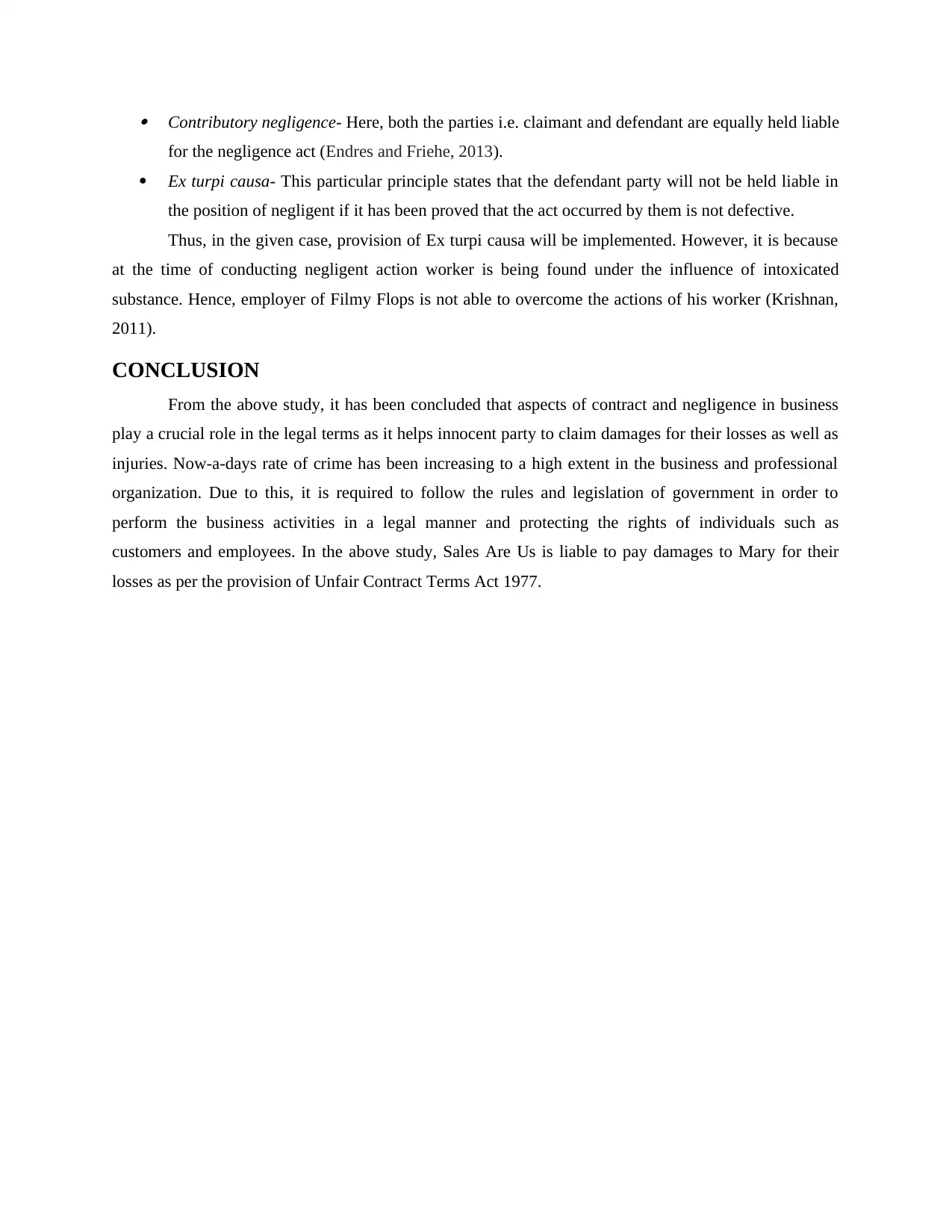
Contributory negligence- Here, both the parties i.e. claimant and defendant are equally held liable
for the negligence act (Endres and Friehe, 2013).
Ex turpi causa- This particular principle states that the defendant party will not be held liable in
the position of negligent if it has been proved that the act occurred by them is not defective.
Thus, in the given case, provision of Ex turpi causa will be implemented. However, it is because
at the time of conducting negligent action worker is being found under the influence of intoxicated
substance. Hence, employer of Filmy Flops is not able to overcome the actions of his worker (Krishnan,
2011).
CONCLUSION
From the above study, it has been concluded that aspects of contract and negligence in business
play a crucial role in the legal terms as it helps innocent party to claim damages for their losses as well as
injuries. Now-a-days rate of crime has been increasing to a high extent in the business and professional
organization. Due to this, it is required to follow the rules and legislation of government in order to
perform the business activities in a legal manner and protecting the rights of individuals such as
customers and employees. In the above study, Sales Are Us is liable to pay damages to Mary for their
losses as per the provision of Unfair Contract Terms Act 1977.
for the negligence act (Endres and Friehe, 2013).
Ex turpi causa- This particular principle states that the defendant party will not be held liable in
the position of negligent if it has been proved that the act occurred by them is not defective.
Thus, in the given case, provision of Ex turpi causa will be implemented. However, it is because
at the time of conducting negligent action worker is being found under the influence of intoxicated
substance. Hence, employer of Filmy Flops is not able to overcome the actions of his worker (Krishnan,
2011).
CONCLUSION
From the above study, it has been concluded that aspects of contract and negligence in business
play a crucial role in the legal terms as it helps innocent party to claim damages for their losses as well as
injuries. Now-a-days rate of crime has been increasing to a high extent in the business and professional
organization. Due to this, it is required to follow the rules and legislation of government in order to
perform the business activities in a legal manner and protecting the rights of individuals such as
customers and employees. In the above study, Sales Are Us is liable to pay damages to Mary for their
losses as per the provision of Unfair Contract Terms Act 1977.
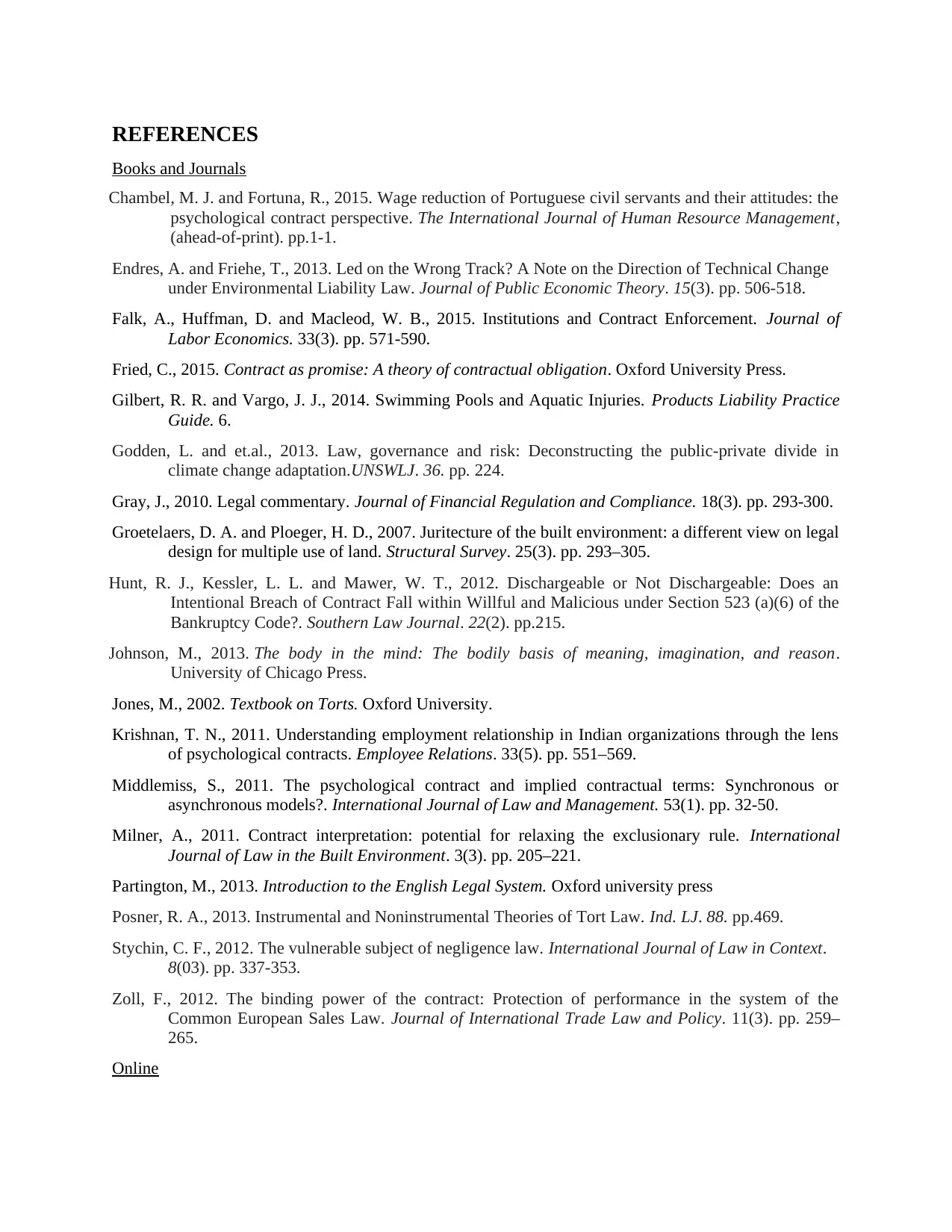
REFERENCES
Books and Journals
Chambel, M. J. and Fortuna, R., 2015. Wage reduction of Portuguese civil servants and their attitudes: the
psychological contract perspective. The International Journal of Human Resource Management,
(ahead-of-print). pp.1-1.
Endres, A. and Friehe, T., 2013. Led on the Wrong Track? A Note on the Direction of Technical Change
under Environmental Liability Law. Journal of Public Economic Theory. 15(3). pp. 506-518.
Falk, A., Huffman, D. and Macleod, W. B., 2015. Institutions and Contract Enforcement. Journal of
Labor Economics. 33(3). pp. 571-590.
Fried, C., 2015. Contract as promise: A theory of contractual obligation. Oxford University Press.
Gilbert, R. R. and Vargo, J. J., 2014. Swimming Pools and Aquatic Injuries. Products Liability Practice
Guide. 6.
Godden, L. and et.al., 2013. Law, governance and risk: Deconstructing the public-private divide in
climate change adaptation.UNSWLJ. 36. pp. 224.
Gray, J., 2010. Legal commentary. Journal of Financial Regulation and Compliance. 18(3). pp. 293-300.
Groetelaers, D. A. and Ploeger, H. D., 2007. Juritecture of the built environment: a different view on legal
design for multiple use of land. Structural Survey. 25(3). pp. 293–305.
Hunt, R. J., Kessler, L. L. and Mawer, W. T., 2012. Dischargeable or Not Dischargeable: Does an
Intentional Breach of Contract Fall within Willful and Malicious under Section 523 (a)(6) of the
Bankruptcy Code?. Southern Law Journal. 22(2). pp.215.
Johnson, M., 2013. The body in the mind: The bodily basis of meaning, imagination, and reason.
University of Chicago Press.
Jones, M., 2002. Textbook on Torts. Oxford University.
Krishnan, T. N., 2011. Understanding employment relationship in Indian organizations through the lens
of psychological contracts. Employee Relations. 33(5). pp. 551–569.
Middlemiss, S., 2011. The psychological contract and implied contractual terms: Synchronous or
asynchronous models?. International Journal of Law and Management. 53(1). pp. 32-50.
Milner, A., 2011. Contract interpretation: potential for relaxing the exclusionary rule. International
Journal of Law in the Built Environment. 3(3). pp. 205–221.
Partington, M., 2013. Introduction to the English Legal System. Oxford university press
Posner, R. A., 2013. Instrumental and Noninstrumental Theories of Tort Law. Ind. LJ. 88. pp.469.
Stychin, C. F., 2012. The vulnerable subject of negligence law. International Journal of Law in Context.
8(03). pp. 337-353.
Zoll, F., 2012. The binding power of the contract: Protection of performance in the system of the
Common European Sales Law. Journal of International Trade Law and Policy. 11(3). pp. 259–
265.
Online
Books and Journals
Chambel, M. J. and Fortuna, R., 2015. Wage reduction of Portuguese civil servants and their attitudes: the
psychological contract perspective. The International Journal of Human Resource Management,
(ahead-of-print). pp.1-1.
Endres, A. and Friehe, T., 2013. Led on the Wrong Track? A Note on the Direction of Technical Change
under Environmental Liability Law. Journal of Public Economic Theory. 15(3). pp. 506-518.
Falk, A., Huffman, D. and Macleod, W. B., 2015. Institutions and Contract Enforcement. Journal of
Labor Economics. 33(3). pp. 571-590.
Fried, C., 2015. Contract as promise: A theory of contractual obligation. Oxford University Press.
Gilbert, R. R. and Vargo, J. J., 2014. Swimming Pools and Aquatic Injuries. Products Liability Practice
Guide. 6.
Godden, L. and et.al., 2013. Law, governance and risk: Deconstructing the public-private divide in
climate change adaptation.UNSWLJ. 36. pp. 224.
Gray, J., 2010. Legal commentary. Journal of Financial Regulation and Compliance. 18(3). pp. 293-300.
Groetelaers, D. A. and Ploeger, H. D., 2007. Juritecture of the built environment: a different view on legal
design for multiple use of land. Structural Survey. 25(3). pp. 293–305.
Hunt, R. J., Kessler, L. L. and Mawer, W. T., 2012. Dischargeable or Not Dischargeable: Does an
Intentional Breach of Contract Fall within Willful and Malicious under Section 523 (a)(6) of the
Bankruptcy Code?. Southern Law Journal. 22(2). pp.215.
Johnson, M., 2013. The body in the mind: The bodily basis of meaning, imagination, and reason.
University of Chicago Press.
Jones, M., 2002. Textbook on Torts. Oxford University.
Krishnan, T. N., 2011. Understanding employment relationship in Indian organizations through the lens
of psychological contracts. Employee Relations. 33(5). pp. 551–569.
Middlemiss, S., 2011. The psychological contract and implied contractual terms: Synchronous or
asynchronous models?. International Journal of Law and Management. 53(1). pp. 32-50.
Milner, A., 2011. Contract interpretation: potential for relaxing the exclusionary rule. International
Journal of Law in the Built Environment. 3(3). pp. 205–221.
Partington, M., 2013. Introduction to the English Legal System. Oxford university press
Posner, R. A., 2013. Instrumental and Noninstrumental Theories of Tort Law. Ind. LJ. 88. pp.469.
Stychin, C. F., 2012. The vulnerable subject of negligence law. International Journal of Law in Context.
8(03). pp. 337-353.
Zoll, F., 2012. The binding power of the contract: Protection of performance in the system of the
Common European Sales Law. Journal of International Trade Law and Policy. 11(3). pp. 259–
265.
Online
⊘ This is a preview!⊘
Do you want full access?
Subscribe today to unlock all pages.

Trusted by 1+ million students worldwide
1 out of 14
Related Documents
Your All-in-One AI-Powered Toolkit for Academic Success.
+13062052269
info@desklib.com
Available 24*7 on WhatsApp / Email
![[object Object]](/_next/static/media/star-bottom.7253800d.svg)
Unlock your academic potential
Copyright © 2020–2025 A2Z Services. All Rights Reserved. Developed and managed by ZUCOL.





